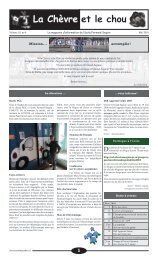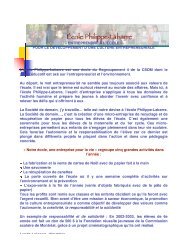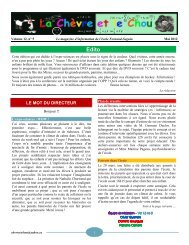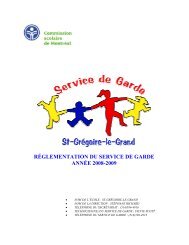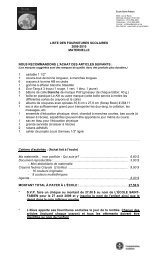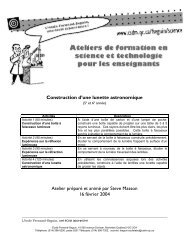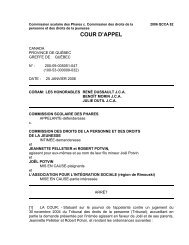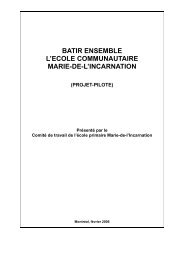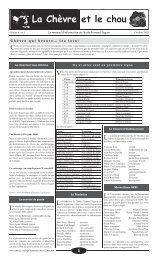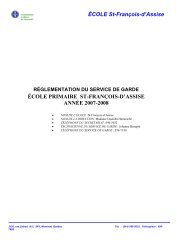Research on Child and Adolescent Mental Health
Research on Child and Adolescent Mental Health
Research on Child and Adolescent Mental Health
Create successful ePaper yourself
Turn your PDF publications into a flip-book with our unique Google optimized e-Paper software.
esearch agenda <strong>on</strong> clinical interventi<strong>on</strong>s for<br />
youth to accomplish four tasks: (1) synthesize<br />
(through reviews of the evidence base) the status<br />
of science <strong>on</strong> promising interventi<strong>on</strong>s, (2) assess<br />
quality indicators of outcomes to improve<br />
st<strong>and</strong>ards of clinical practice, (3) evaluate<br />
outcome measures, <strong>and</strong> (4) develop a new<br />
research phase model for c<strong>on</strong>necting research to<br />
practice. Important to this effort is not <strong>on</strong>ly<br />
identifying the evidence base <strong>on</strong> service<br />
effectiveness but also attending to the models of<br />
disseminati<strong>on</strong> that will enable it to be used in<br />
clinical practice. The aim is to address historically<br />
intractable problems through learning how to<br />
shift relevant evidence-based interventi<strong>on</strong>s to<br />
youth with the most severe disorders. Critical<br />
activities will include (1) establishing criteria for<br />
interventi<strong>on</strong>s to be disseminated, (2) developing<br />
“user-friendly” training <strong>and</strong> supervisory <strong>and</strong><br />
quality m<strong>on</strong>itoring materials, <strong>and</strong> (3) c<strong>on</strong>ducting<br />
disseminati<strong>on</strong> research to test theoretical <strong>and</strong><br />
empirical approaches for changing practiti<strong>on</strong>er<br />
<strong>and</strong> organizati<strong>on</strong>al behavior.<br />
A comprehensive disseminati<strong>on</strong> <strong>and</strong> knowledge<br />
transfer program would involve all three of these<br />
classes of activities. It would require that research<br />
findings, after having successfully g<strong>on</strong>e through<br />
rigorous scientific peer review procedures, be<br />
provided in formats <strong>and</strong> language appropriate for<br />
other audiences, such as providers <strong>and</strong><br />
c<strong>on</strong>sumers. Above <strong>and</strong> bey<strong>on</strong>d the preparati<strong>on</strong> of<br />
appropriate materials, a comprehensive <strong>and</strong><br />
effective disseminati<strong>on</strong> effort requires an<br />
interpers<strong>on</strong>al comp<strong>on</strong>ent. The Nati<strong>on</strong>al Center for<br />
the Disseminati<strong>on</strong> of Disability <str<strong>on</strong>g>Research</str<strong>on</strong>g> (NCDDR)<br />
(1996) reported that perhaps the most c<strong>on</strong>sistent<br />
<strong>and</strong> ubiquitous finding in the literature <strong>on</strong><br />
knowledge utilizati<strong>on</strong> is the primacy of pers<strong>on</strong>al<br />
interacti<strong>on</strong>, <strong>and</strong> Cr<strong>and</strong>all (1989) indicated that<br />
“adequate materials <strong>and</strong> procedural guidelines,<br />
coupled with resp<strong>on</strong>sive, in-pers<strong>on</strong> assistance<br />
during later implementati<strong>on</strong>, are imperative for<br />
maximum success.” This finding is c<strong>on</strong>sistent<br />
with the finding that credibility of the source of<br />
informati<strong>on</strong> is critical for knowledge utilizati<strong>on</strong>.<br />
“Credibility” refers to both the level of perceived<br />
expertness <strong>and</strong> trustworthiness (NCDDR, 1996).<br />
Pers<strong>on</strong>al interacti<strong>on</strong> is very important for<br />
promoting a level of trust that is more likely to<br />
result in utilizati<strong>on</strong> of research findings.<br />
The implicati<strong>on</strong>s are that even with advances in<br />
technology, in the complex area of interventi<strong>on</strong>s<br />
for child mental health disorders, effective<br />
knowledge transfer is labor-intensive <strong>and</strong><br />
expensive. <str<strong>on</strong>g>Research</str<strong>on</strong>g>ers who have developed<br />
successful interventi<strong>on</strong>s need to be prepared to<br />
resp<strong>on</strong>d to requests for assistance <strong>and</strong> to<br />
proactively generate interest from groups that<br />
may implement the interventi<strong>on</strong> with high fidelity<br />
to its principles <strong>and</strong> processes. Agencies such as<br />
NIMH <strong>and</strong> CMHS that are interested in promoting<br />
the use of evidence-based interventi<strong>on</strong>s in<br />
children’s mental health need to identify<br />
mechanisms to study <strong>and</strong> support this process.<br />
CROSSING THE BOUNDARIES<br />
It is increasingly clear that a goal of public health<br />
science is ensuring that science-based services are<br />
embedded into everyday practice <strong>and</strong> used by all.<br />
Doing so necessitates new areas of<br />
investigati<strong>on</strong>— what might be called<br />
disseminati<strong>on</strong> <strong>and</strong> implementati<strong>on</strong> science—to<br />
underst<strong>and</strong> how best to positi<strong>on</strong> <strong>and</strong> sustain<br />
effective services in communities <strong>and</strong> identify<br />
factors that impede this positi<strong>on</strong>ing. Achieving<br />
this goal requires both a new genre of study <strong>and</strong><br />
persistent attenti<strong>on</strong> to questi<strong>on</strong>s about why<br />
services are effective. Toward this end, scientists<br />
must engage families, providers, <strong>and</strong> other mental<br />
health stakeholders to increase the likelihood that<br />
the research is relevant to their needs <strong>and</strong> will<br />
produce findings that are credible <strong>and</strong><br />
scientifically valid.<br />
71



